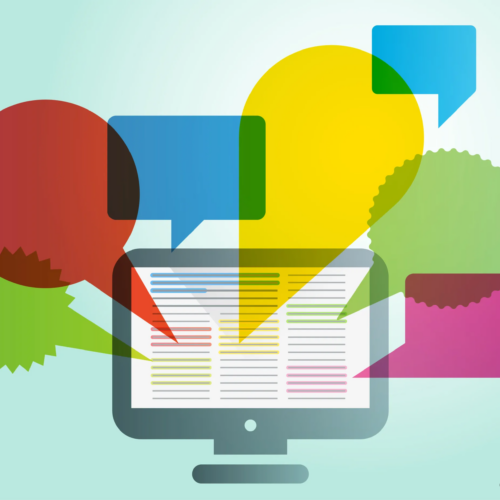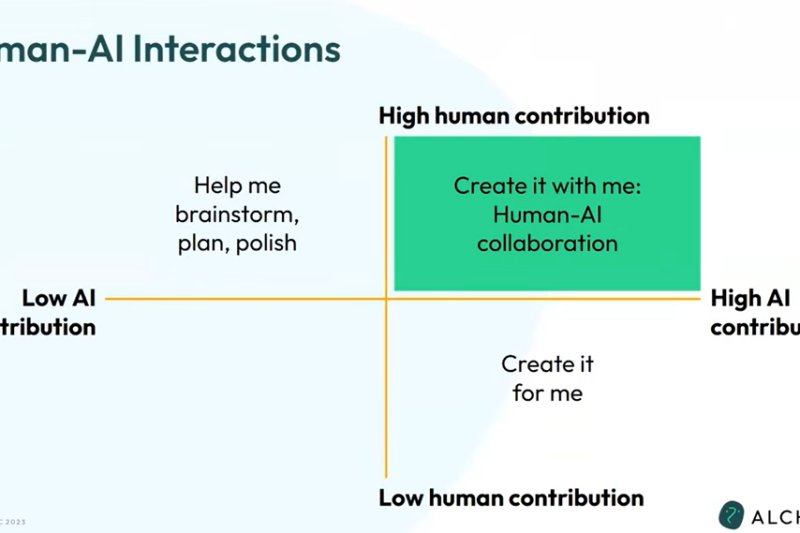
(Re-)Designing Assignments where Students Collaborate with Artificial Intelligence
To help you prepare for teaching and learning in the age of artificial intelligence (AI), here is a pedagogical approach, plus some extra resources, to help you tackle assignment design. These ideas aim to help you reinforce your learning goals and prepare students for the future, which I believe, involves collaboration with AI.
Why Collaborate with AI?
I heard at a conference that AI should actually stand for Assisted or Augmented Intelligence, which I think makes more sense. AI is certainly powerful, but it requires, at minimum, prompting to start a task and a lot of humans to program it in the first place. Below is one illustration of tasks where the AI and human contributions may vary. Human contribution is most useful for multi-dimensional, complex tasks with unexpected events, but much of our everyday work can be handled by technology.
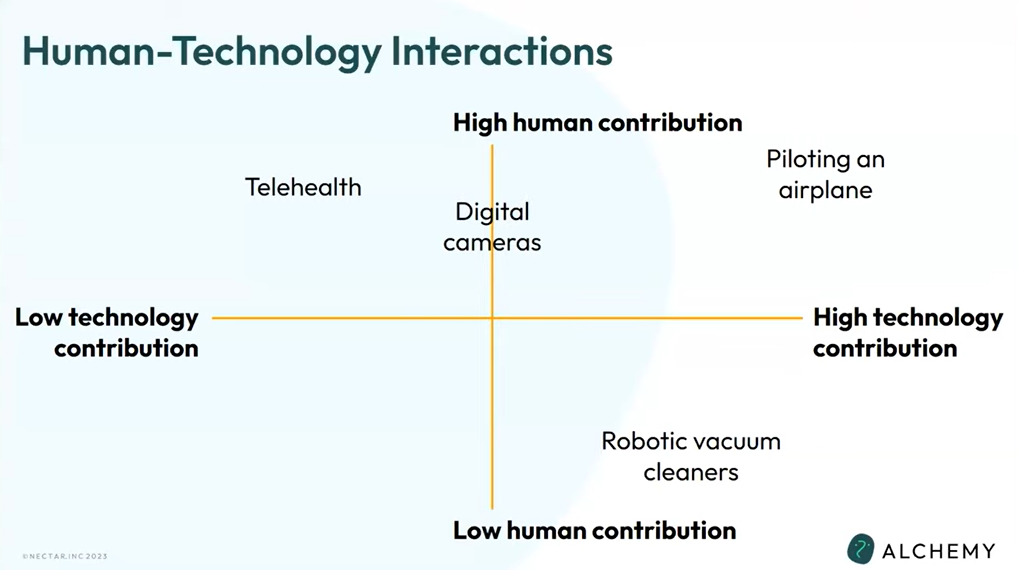
AI is infiltrating everyday life, almost every profession, and the academic fields of the future. In business, marketers are using AI to write content and format it for specific consumer goals. In engineering, coders are using AI to generate initial code and get feedback to expedite their creative processes. Researchers of various fields are using AI to run simulations, analyze data, and polish up papers.
Now, AI is embedded in many tools we commonly use on our campus, including those supported by WashU (Microsoft Word, Gmail, Padlet, Gradescope, etc.). Most of us will use these tools without knowing it, and many of us will deliberately seek out these tools to help complete a task, solve a problem, begin brainstorming, reduce administrative work, get help, and more. Hence, using AI is not only inevitable, but valued in most aspects of life. You can learn more at Inside Higher Ed Emerging Technology and AI report (June 2023).
Knowing how to use AI well for specific goals will certainly play a role in the future workplace. To prepare students, we need to recognize AI’s role and, if possible, leverage it so that it enhances teaching and learning. This means a high level of both human + AI contribution in a way that helps both students and technologies grow. At times, this may mean that you keep AI contribution low so that students build essential skills, and at other times you keep human contribution low so that AI can flourish in what it does best and humans can learn how to use it effectively. The method below will help you consider how to create with AI as depicted in the top right quadrant in this figure:

Spectrum Method
The spectrum method considers human to AI collaboration as a range to which students and AI can contribute to different degrees to individual assignments. For instance, consider what contribution may look like for an essay assignment either created completely by AI or by a student:
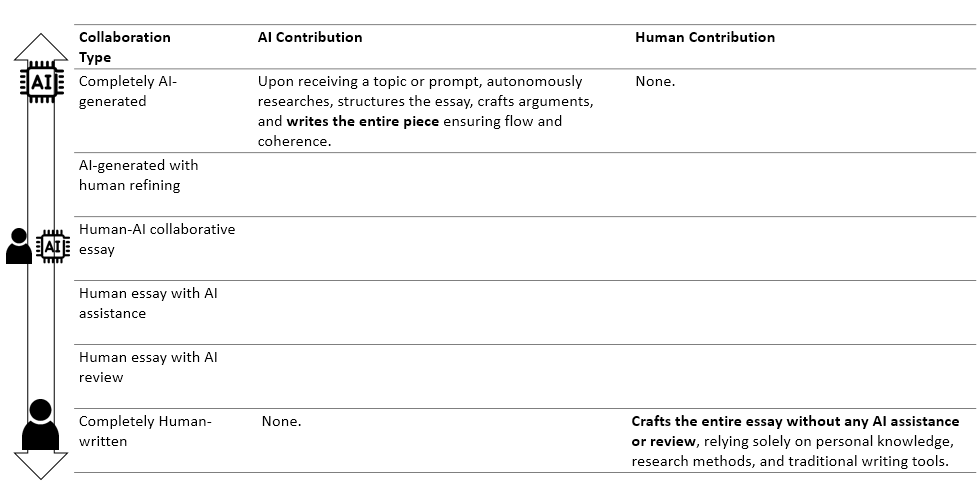
In between the extremes of only AI or only human contribution are forms that will likely become more common, particularly human essay with AI review, which has been generally accepted as tools like Grammarly have come on the scene to help students check essays for grammar and style improvements. Even AI-generated essays with human refining could become commonplace in specific contexts where it makes sense to have AI generate a generic idea or general framework for humans to then tweak (think: anything that may already have a template or standard language, e.g., emails, contracts, slogans).

The value of outlining these different types along the spectrum is that it helps you see where AI may contribute and decide what level of student and AI contribution makes sense. In my workshops, I ask participants to copy/modify a table or create their own using AI prompts, all provided in this open, collaborative document that I invite you to contribute to.
Short link: https://tinyurl.com/HumanAISpectrum
In the collaborative document, you can also find additional tables for different assignments from coding to independent research. Feel free to copy and build on these tables.
Once you have a table that clearly outlines where humans and AI can contribute, it can also serve as a communication tool specifying what the boundaries are for your class assignment. See the figure below for an example where human essay with AI review is allowed, but additional AI contribution is not permitted (i.e., students can use Grammarly or similar tools).
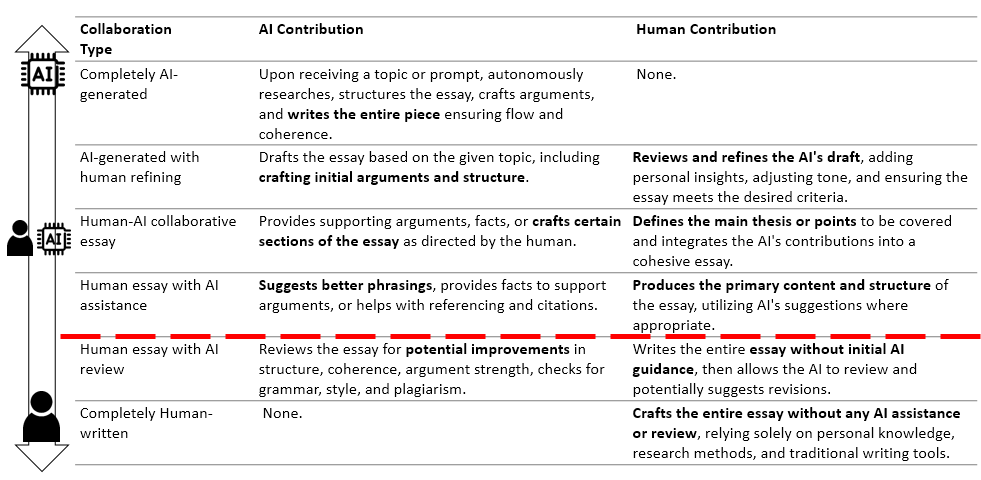
No matter what you choose, I suggest walking students through the table, your boundary, and specifying why that boundary is drawn where it is. There are great reasons from “no AI is allowed in this intro language course so that you learn to construct grammar yourself” to “it’s not a problem to use AI to generate code, but you need to adjust it to fit into the rest of the code that a company may be using.”
Use this chance to reinforce your learning objectives for students and connect the assignment to a larger why. Here are some questions that you can consider as you go through the process of modifying/building your table and drawing your boundary:
- What does the future of work look like in your discipline? How will your academic and professional contexts leverage AI to enhance its work?
- Where will students need to know how to use AI (and how to not use AI) to do their work?
- Where does your class fit into students’ academic experience? What human-specific skills should they learn now? What AI-related skills should they learn now?
- What are your learning goals for students? What should they be able to do/know on their own and thus need to practice/apply? What should they be able to do/know with the help of AI?
Extra Resources
Want some more basic information about generative AI tools, particularly ChatGPT? See our CTL resources with recommendations for ChatGPT and AI Composition Tools or Incorporating ChatGPT into Your Assignments. You can also contact us to discuss your teaching goals or learn more at ctl@wustl.edu.
Don’t like this spectrum approach, particularly for assessments? Consider the two-lane method from Professor Danny Kim at the University of Sydney, which balances AI contribution with student assessments within a controlled environment. You can learn more about this method in a session on Harnessing the Power of AI: Transforming Assignments and Assessments in Higher Education (YouTube video), where I got the wonderful images in the “Why Collaborate with AI?” section above.
Learn more about how AI will be used by your students in academic and professional contexts. Current and future usage in various disciplines range from political campaigns writing emails to a changing landscape of software development. Students may even be recruited by companies that provide ChatGPT Plus as a work perk. Talk with your colleagues (and students!) about what they see in your field. These approaches work best in conjunction with wider departmental discussions about how students should (or should not) be collaborating with AI as they move from introductory to advanced courses in your discipline. Perhaps boundaries move up or down to align with AI collaboration skills essential to their future as professionals, scholars, and citizens of the world.
